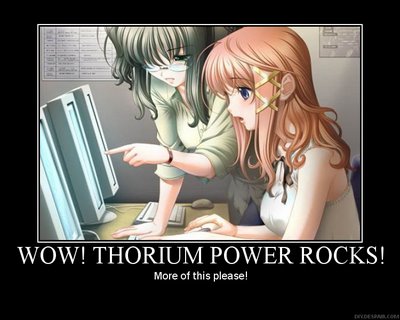Perhaps NIH syndrome is at work here.
At any rate, the science babes have been looking at something a bit better....

...they have been perusing with some interest one particular website with an unfathomably cryptic name. Despite uncertainties about the sites subject matter, they determined early on that it involves using thorium (Th)rather than uranium to obtain energy. Kirk Sorensen, the, webmaster behind the site has been advocating a molten salt reactor powered by Th for some time. My first reaction to this was negative given the lack of success that the USS Seawolf had with its first reactor. However, Sorensen is proposing a quite different design. He points out in his basic principles page the inherent advantages of this system, not the least of which is that Thorium is about 3 times as abundant as Uranium!
Now there is going to be some skepticism regards a new and theoretical reactor design, but this type of reactor is neither. Here is the history of the liquid fluoride reactor beginning with the clinically insane Air Force plan to put a nuclear reactor in an aircraft.(WTF!?) The reactor for that had to be pretty darned safe even in the '50's, and though a flying nuke plant is just cuckoo for cocoa-puffs, the reactor design, if not in a plane, is remarkably safe and efficient. The other thing about the design is that it is a breeder meaning that it creates fuel, allowing VERY efficient use of its fuel. (like petroleum terrestrial thorium deposits though fairly common are finite). Several of these reactors have been designed and built but they have not been pursued for a variety of non-technical reasons.
Breeders get a bad rap because they could lead to plutonium proliferation, but the liquid-fluoridereactor, if operated on a pure thorium/U233 cycle,does not produce any plutonium because its precursors are removed. U233 itself is always contaminated with coproducts that make it unattractive for weapons, and this effect can be enhanced by "spiking" the thorium with ionium (Th-230).. This greatly complicates any attempt to use it for nefarious purposes. Of course, in areas of the world like Africa and southwest Asia where proliferation is a real issue, pebble-bed reactors can be used for the time being.
Because the reactor can completely burn its nuclearfuel, the remaining nuclear waste decays to backgroundlevels of radiation in only a few hundred years. Also,since the reactor's fuel is molten, a China-syndrometype accident is virtually meaningless, since the fuel can be drained..which will stop the reaction and remove residual decay-heat.
This has incredible potential for spacecraft/ space base power given its extremely compact and very safe design, though radiator design would be rather challenging (it operates at VERY high temperature)it would lend itself admirably to a Nuclear Thermal Rocket like Triton or NERVA. Again, the saftey options are quite impressive as well.
Recently, Kirk put up a long, link-rich and informative piece on the actual design of the prototype aircraft reactor which was built and tested. This was in 1954! This is NOT far-future/ theoretical technology!
We just need to increase awareness and get some impetus behind this design.
Anyhoo I'm adding this site to the brickmuppetblogroll.
Update 1) 11/06/06 : Clarified 2 technical points as per the request of Mr. Sorensen who kindly pointed them out.
Update 2) 11/06/06 : Looking at this old design for the aircraft reactor, one is struck by how COMPACT it is. About 12 feet long and 10 feet high....for 200 megawatts of power. This is smaller than many commercial marine diesels! In the future, fuel savings could make it very viable commercially(I like the PBR too, but I don't see it being practical on a ship).
200 MW would have obvious potential for a warship (sensors are energy hogs, and in the farther term, lasers and railguns) but for a Coast Guard cutter it would have interesting values indeed. This would give a mid-sized cutter the potential to have a desalination plant capable of supplying a city in a major relief operation as well as providing power for thousands (think S-Asian Tsunami or Katrina). An icebreaker could use really hot water or steam for its bubbler system greatly facilitating icebreaking and of course the high speed implied by the air heating turbines could facilitate rescue operations.
No comments:
Post a Comment